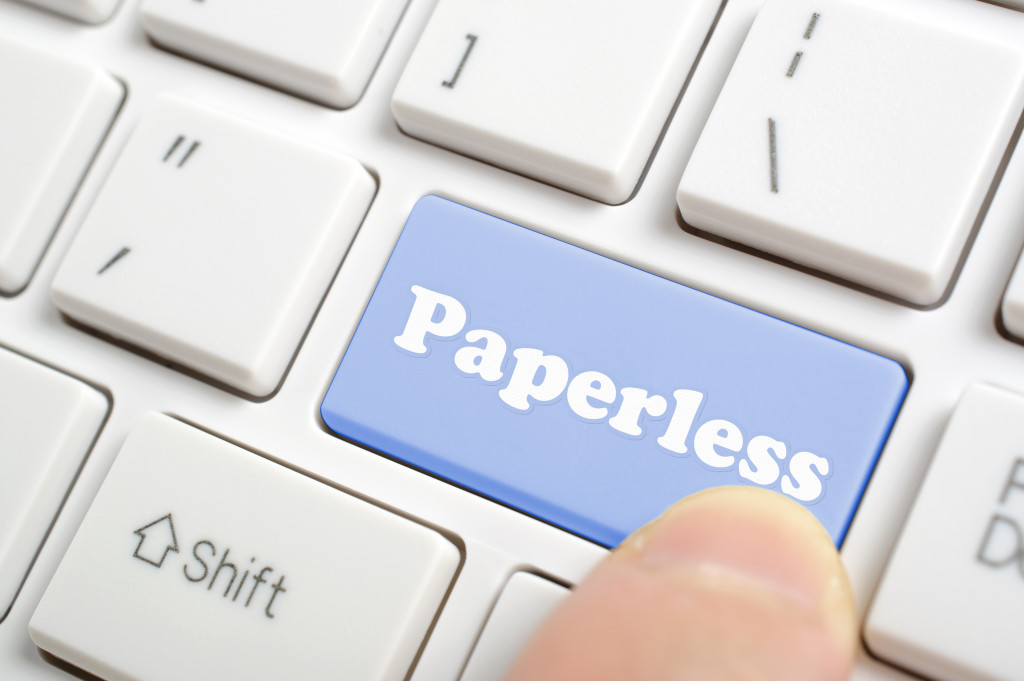Sustainability is increasingly becoming a priority for businesses around the world. Companies are looking for ways to reduce their environmental impact and improve their business operations. One of the most effective strategies companies can take to help achieve sustainability is by going paperless. Going paperless can significantly reduce energy consumption, costs, and waste from producing paper and its disposal.
Not only does going digital help businesses become more sustainable, but it often leads to increased efficiency and productivity and reduced costs associated with operating business processes such as invoicing or customer onboarding. A survey by Xerox in 2020 across North America found that nearly 75% reported improved efficiency when switching from a paper-based process to digital alternatives for document management tasks such as document storage or searching for information within those documents. In addition, 74% reported improved compliance when switching from a paper-based system. Going digital could also potentially lead to increased customer satisfaction due to faster response times since more time doesn’t have to be spent manually sorting through hundreds of pages of paperwork before finding the relevant information related to customer queries or orders.
However, going paperless will not be an easy transition for many businesses. It will require a shift in mindset and time to properly understand the digital tools available and how they might best suit a company’s needs. Here are a few tips for businesses looking to go paperless.
Review Existing Processes
When reducing paper waste, one of the first steps businesses should take is to review their existing processes and identify areas where they can reduce their reliance on paper. This could include streamlining their invoicing process or looking for digital alternatives to physical documents. By closely examining each existing process, businesses can determine what methods rely on paper the most and where they can improve efficiency, such as automating specific repetitive tasks that require manual input.
One popular way to review existing processes is to use a workflow diagram. A workflow diagram visually outlines a task’s steps, including the people involved and any dependencies between those steps. By analyzing the workflow diagram, businesses can quickly identify which parts of the process rely most on paper and find potential alternatives that would allow them to reduce their dependence on physical documents. For instance, if a business generates many customer orders manually with pen and paper, it might be able to automate this process by using an online order form instead. Or suppose customer onboarding requires employees to fill out forms with customers’ information manually. In that case, they could use customer relationship management (CRM) software that captures this data digitally and stores it securely in one place for future reference.
Boosting Online Presence

One of the underlying benefits of going paperless for businesses is seeing how they can improve their online presence. As more customer interactions and operations shift from physical to digital, companies must ensure their website is optimized for mobile devices and provides an easy and understandable customer experience. An active social media presence can also drive customer loyalty and increase brand visibility. This could include posting helpful content on topics related to the business or engaging with customers through posts or conversations.
Once the content is online, businesses can utilize Search Engine Optimization (SEO) techniques to increase their website’s visibility on search engines and maximize the chances of appearing on the first page of search results. This will help bring more customers to their product or service pages and provide potential leads that may be interested in what they offer. You can get affordable SEO services to help with this process.
Going paperless is not only good for the environment; it can also be beneficial for businesses in
Finally, businesses should consider investing in marketing automation software and analytics tools to track performance metrics such as website visits, conversions, leads generated, and more. These insights will provide valuable insight into what’s working—and what’s not—so companies can adjust their strategies accordingly.
Creating Sustainability Metrics
Going paperless is about more than just reducing paper waste; it’s also essential for businesses to track and measure the sustainability of their operations. By creating specific metrics that measure their progress towards becoming paperless, companies can monitor how well they are doing regarding resource usage and environmental impact.
These metrics could include tracking energy consumption or water usage, measuring carbon emissions from business operations, or calculating the number of trees saved through reduced paper use. Setting these sustainability goals will give companies a better understanding of how their efforts are paying off and whether further changes need to be made to continue toward greater sustainability. By tracking their progress towards becoming paperless, businesses can ensure that they remain environmentally responsible while running their operations efficiently. By creating a culture of sustainability within the organization, companies can stay focused on finding ways to reduce their environmental impact. These efforts not only benefit the planet—but they also create a healthier working environment for employees and ultimately improve customer experiences.
Final Thoughts
Overall, going paperless offers many opportunities for businesses to become more efficient and sustainable while still providing customers with excellent service and products. By taking the necessary steps to reduce dependence on physical documents, utilizing online presence strategies, investing in marketing automation software, and tracking sustainability metrics, businesses can reap the many benefits of going paperless without sacrificing profitability or customer experience.

